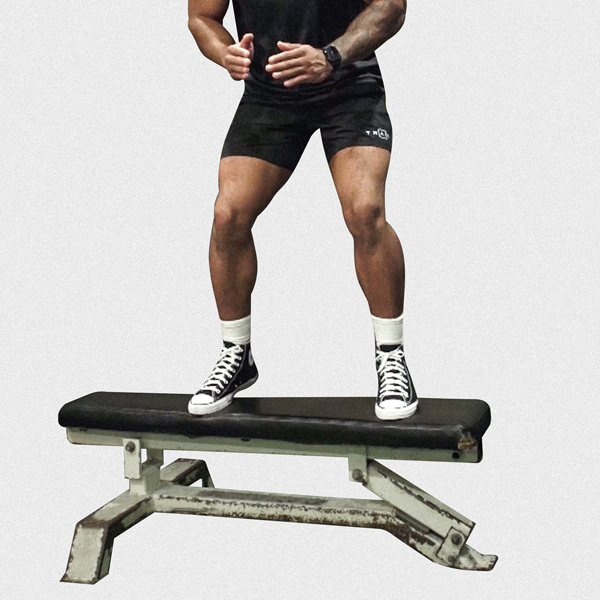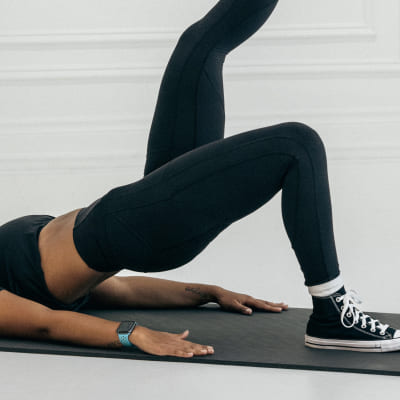Box Jump
 Auto Detected
Auto DetectedA plyometric exercise using a box to explosively train the glutes, quads, and hamstrings. It is primarily used to develop speed, power, and conditioning for athletic performance.
About Exercise
Equipment
Plyometric Box
Difficulty
4/5 • Intermediate
Primary Muscle Groups
Glutes, Quads
Secondary Muscles
Calves, Abs
Popularity Score
8
Goals
Training Style
Setup Requirements
Requires Rack
No
Requires Bench
No
Requires Spotter
No
Space Needed
Medium
Noise Level
Moderate
Muscle Breakdown
View Muscle MapGlutes
9/10Glute Max
Quads
8/10Vastus Lateralis, Rectus Femoris
Hamstrings
6/10Biceps Femoris
Calves
5/10Gastrocnemius
Abs
3/10Rectus Abdominis
Programming
Typical Rep Range
5-10 reps
Rest Between Sets
60-180 seconds • Rest longer (90+ seconds) when training maximum power output.
How to Perform
Stand facing a sturdy plyometric box or stable platform placed about a foot away. Assume a quarter-squat stance with feet hip-width apart and knees slightly bent.
- Hinge slightly and swing your arms back, rapidly dropping into a deeper quarter-squat.
- Explosively jump upward and forward, driving through the floor and swinging arms forward.
- Land softly and quietly on the entire foot on top of the box in a quarter-squat position.
- Stand tall by fully extending the hips and knees to finish the repetition.
- Step down from the box one foot at a time to return to the starting position.
Coaching Tips
Form Cues
- Land soft and quiet.
- Explode through the floor.
- Use your arms for momentum.
- Chest up tall.
- Jump, don't step.
Breathing
Inhale during the countermovement phase and forcefully exhale as you explode into the jump. Brace your core throughout.
Tempo
X-0-X
Range of Motion
The movement spans from a slight squat on the floor to a complete standing position on top of the box, with a soft landing in between.
Safety
Safety Notes
- Use a stable box or platform that is secured or heavy.
- Always step down, especially when fatigued, to prevent tripping.
- Ensure the height is appropriate to land safely without crashing.
- Do not perform if experiencing acute knee or ankle pain.
Spotting
Not recommended; ensure the box is stable and the height is manageable for safe landing.
Common Mistakes
- Jumping off the box backward instead of stepping down.
- Landing with stiff knees (little knee bend).
- Over-relying on arm swing instead of leg power.
- Using a box that is too high for safe landing.
- Jumping from too far away.
When to Avoid
- Acute knee or ankle injuries.
- Severe balance issues.
Flexibility Needed
- Adequate ankle dorsiflexion for squat landing.
- Basic hip and knee flexion range of motion.
Build Up First
- Competency in controlled jumping and landing mechanics.
- Mastery of bodyweight squat.
Also known as
The Box Jump, Box Jumps (Plyometric), Box Jumps
Found this helpful?
Share your thoughts or help us improve this guide.
Similar Exercises

Box Jump

Plyometric Box
Glutes

Jumping Jacks

Body Weight
Calves

Barbell Box Squat
Barbell, Plyometric Box
Glutes

Burpee Broad Jumps
Body Weight
Quads

Dumbbell Box Goblet Squat
Dumbbells, Plyometric Box
Quads

Jump Rope

Jump Rope
Calves

Balance Trainer Sumo Squat Jumps
Balance Trainer
Glutes

Balance Trainer Alternating Lunge Jumps
Balance Trainer
Quads

Barbell Jump Squat
Barbell, Plates
Quads

Step Up
Body Weight, Plyometric Box
Quads


subscribe to our newsletter
Contact Us
hello@trainfitness.aiFind Us
130 Spadina Avenue, Toronto,
Ontario, M5V 0H4, Canada
©2025 All Rights Reserved
